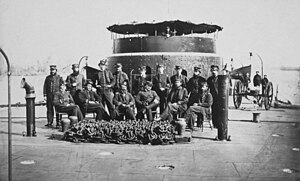
Back Манітор (карабель) Byelorussian Монитор (вид кораб) Bulgarian Monitor (typ lodi) Czech Monitor (Schiffstyp) German Monitoro (batalŝipo) Esperanto Monitor (barco) Spanish Monitor (laevatüüp) Estonian Monitor (gerraontzia) Basque مانیتور (کشتی) Persian Monitorialus Finnish


A monitor is a relatively small warship that is neither fast nor strongly armored but carries disproportionately large guns. They were used by some navies from the 1860s, during the First World War and with limited use in the Second World War.
The original monitor was designed in 1861 by John Ericsson, who named it USS Monitor. Subsequent vessels of this type were accordingly classed as "monitors".[1] They were designed for shallow waters and served as coastal ships. The term also encompassed more flexible breastwork monitors, and was sometimes used as a generic term for any turreted ship.
In the early 20th century, the term was revived for shallow-draught armoured shore bombardment vessels, particularly those of the Royal Navy: the Lord Clive-class monitors carried guns firing heavier shells than any other warship ever has, seeing action (albeit briefly) against German targets during World War I. The Lord Clive vessels were scrapped in the 1920s.
The term "monitor" also encompasses the strongest of riverine warcraft, known as river monitors. During the Vietnam War these much smaller craft were used by the United States Navy.[2] The Brazilian Navy's Parnaíba and the Romanian Navy's three Mihail Kogălniceanu-class river monitors are among the last monitors in service.

- ^ "monitor 1.4.b". Oxford English Dictionary (Online ed.). Oxford University Press. (Subscription or participating institution membership required.)
- ^ Carrico p. 10, 11